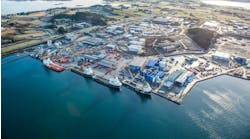Alstom's Swedish plant adapts test rig for dual-fuel turbine
Veronica Murillo
Business Editor
Alstom has expanded its gas turbine test plant in Finspong, Sweden, adding a new test rig to examine the company's latest model, the dual-fuel, low emission GT10C turbine. The facility can accommodate both gas and liquid fuel. A 17-m tank, with 100 cu m volume, will provide the turbine with gas. The rig is also equipped with auxiliary, control, fuel, and lubricating oil systems. Approxi-mately 20 turbine tests are planned, with the program in each case expect-ed to take up to three weeks to comp-lete.
FPSO deliveries
Alstom reports that 25% of its clients are in the offshore oil and gas industry, while 21% are involved in gas pipelines. The company has a long track record supplying turbines to platforms, mainly in the North Sea. Last year, it also received its first orders for FPSOs.
The key drivers for gas turbine users in the offshore sector are availability, reliability, and service support. Alstom says its GT10C turbine, although not yet in service, is reliable because the turbine was built largely on principles derived from its predecessor, the GT10B. It offers increased power output - 30 MW, compared with 25 MW for the G10B - yet occupies the same footprint, as both engines use the same base frame.
Engineers balance the GT10C rotor at the Fingspong center in Sweden. Alstom has expanded the center to test the GT10C turbine.
This increased power has been achieved by designing the turbine to operate at a higher temperature, through cooling the turbine's first blades. It is targeted in part at existing Alstom clients seeking a replacement for a long-serving G10B turbine installation as an alternative to a costly overhaul program.
Increasingly, Alstom says, offshore clients are looking for fuel flexibility and twin-shaft, speed-variation capability. Both turbines can be used for mechanical drive and power generation, and both are equipped for offshore application with standard anti-corrosion materials and coatings.
The GT10C is claimed to be 37.3% efficient in simple cycle and 50% efficient in combined cycle. It weighs 35,700 lb and slides sideways for easy removal.
The turbine features 11 compressor stages, the first two of which have variable inlet guide vanes. The rotor is made of discs that are welded to a single robust unit through electron-beams. The first stage of the inlet guide vanes has convection cooling with film-cooled edges. Shrouded blades and honeycomb seals are introduced in the second stage. The combustion chamber is annular and is made of welded sheet metal. The inner surface of the combustor has a thermal barrier coating to reduce heat transfer levels.
Dry emission control is available for both liquid and gaseous fuels. Alstom's Advanced Environmental Vortex burner, already used in its other gas turbines, has the capability to limit nitrous oxide emissions to 15 ppm, at 15% oxygen, when operating on gaseous fuel.
Carbon dioxide emissions are limited to 25 ppm at 15% oxygen for both gas and oil. For maintenance purposes, the burners can be removed from the GT10C's annular combustor without the need to dismantle the gas turbine.
The two-stage power turbine is a free shaft turbine, where the discs are bolted to the shaft. When used for power generation, a gearbox is connected to the power turbine through a flexible coupling of membrane type. Turbine speed is then reduced to 1,500-1,800 rpm from 6,500 rpm. When used for mechanical drive, the coupling is connected directly to the driven component, such as a pump or a compressor.
For more information, contact Inger Welander, Alstom Power. Tel: +46 122 819 49, fax: +46 122 165 80, email: [email protected].
The joint venture between the National Petroleum Construction Co. of Abu Dhabi and Naft Sazeh Qeshm of Iran recently awarded Alstom two orders totaling $28.4 million to supply five gas turbine generating sets for the Soroosh and Nowrooz integrated development project off Iran. The order consists of three 17 MW GT35 gas turbine sets for Soroosh, to be manufactured in Finspong (contract value around $16 million), and two 7.9 MW Tempest gas turbine generating sets for Nowrooz, provided by Alstom's Lincoln, UK, facility.
The GT35s will be used for power generation, with two in permanent operation and one on standby. This brings the number of GT35s in service offshore around the world to 21, with four of these operating on FPSOs. According to an Alstom spokesperson, its turbines were selected for this project due to their "proven reliability, and the fact that they could match the customer's power requirements. The customer required 13 MW output, but at high ambient temperatures. Our GT35 has a nominal output of 17 MW, though somewhat lower in this high-temperature application."
NPCC-NSQ has the EPC contract to install eight platforms for the two fields, let by the project's operator Shell. The turbine generating sets are scheduled for delivery in October. Full production is planned for August 2003, when total production of the two fields should reach 190,000 b/d. The Lincoln site was also contracted recently to supply two gas turbine generating sets, two gas turbine compressor drivers, and two gas turbine pump drivers to SBM for a new FPSO destined for a field offshore West Africa.




